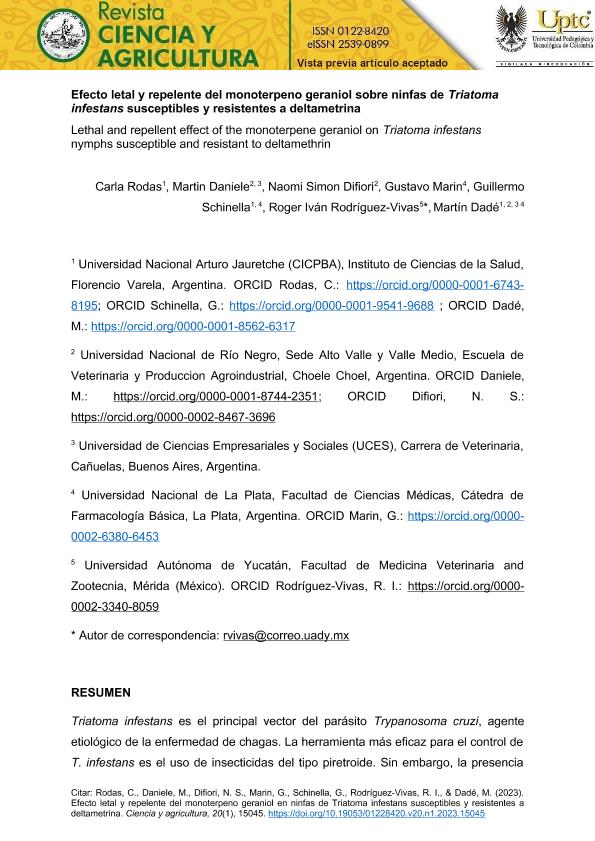Mostrar el registro sencillo del ítem
dc.contributor.author
Rodas, Carla
dc.contributor.author
Daniele, Martin Rafael

dc.contributor.author
Simón Difiori, Naomi
dc.contributor.author
Marin, Gustavo Horacio

dc.contributor.author
Schinella, Guillermo Raúl

dc.contributor.author
Dadé, Martin Miguel

dc.date.available
2024-01-16T14:03:50Z
dc.date.issued
2023-10
dc.identifier.citation
Rodas, Carla; Daniele, Martin Rafael; Simón Difiori, Naomi; Marin, Gustavo Horacio; Schinella, Guillermo Raúl; et al.; Efecto letal y repelente del monoterpeno geraniol sobre ninfas de Triatoma infestans susceptibles y resistentes a deltametrina; Universidad Pedagógica y Tecnológica; Ciencia y Agricultura; 20; 1; 10-2023; 15045-15058
dc.identifier.issn
0122-8420
dc.identifier.uri
http://hdl.handle.net/11336/223777
dc.description.abstract
Triatoma infestans es el principal vector del parásito Trypanosoma cruzi, agente etiológico de la enfermedad de chagas. La herramienta más eficaz para el control de T. infestans es el uso de insecticidas del tipo piretroide. Sin embargo, la presencia de ejemplares de T. infestans resistentes a los piretroides conlleva a la necesidad de buscar nuevas alternativas para su control. Los bioinsecticidas se posicionan en la actualidad como una alternativa novedosa, menos agresiva para el ambiente y de menor costo con respecto al uso de los insecticidas sintéticos tradicionales. El geraniol es un monoterpeno que ha demostrado tener actividad insecticida y repelente en insectos. Los objetivos del presente trabajo fueron determinar y comparar la actividad letal y repelente del geraniol solo y en combinación con el insecticida piretroide deltametrina y el repelente de insectos N,N-Dietil-metatoluamida (DEET). Se demostró que el geraniol tiene una actividad letal similar en ninfas susceptibles y resistentes a piretroides (grado de resistencia de 0,8). Cuando se combinaron los dos insecticidas, el geraniol mostró un efecto sinérgico sobre la letalidad de la deltametrina. En cuanto a la actividad repelente, a bajas concentraciones, el geraniol fue menos potente que el DEET; sin embargo, cuando se combinaron ambas moléculas, la presencia de este monoterpeno aumentó la capacidad de repelencia del DEET al 100%. Se concluye que el geraniol tiene actividad letal sobre ninfas de T. infestans susceptibles y resistentes a los piretroides y tiene un efecto sinérgico sobre la letalidad de la deltametrina. Asimismo, el geraniol aumentó la capacidad de repelencia del DEET sobre T. infestans.
dc.description.abstract
Triatoma infestans is the main vector of the Trypanosoma cruzi parasite, the etiological agent of Chagas disease. Pyrethroid insecticides are the most effective strategy for controlling T. infestans. However, the presence of specimens of T. infestans resistant to pyrethroids now raises the need to seek new alternatives for their control. Bioinsecticides are currently positioned as a novel alternative, less aggressive for the environment and less costly compared to traditional synthetic insecticides. Geraniol is a monoterpene that has been shown to have insecticidal and repellent activity on insects. The objectives of this work were to determine and compare the lethal and repellent activity of geraniol alone and in combination with the pyrethroid insecticide deltamethrin and the insect repellent N,N-Diethyl-meta-toluamide (DEET). Geraniol has been shown to be similar lethal to pyrethroid-susceptible and -resistant nymphs (resistance ratio of 0.8). When the two insecticides were combined, geraniol showed a synergistic effect on the lethality of deltamethrin. In terms of repellent activity, geraniol was less effective than DEET at low concentrations; however, when both molecules were combined, the presence of this monoterpene increased the repellency capacity of DEET to 100%. It is concluded that geraniol has lethal activity on T. infestans nymphs susceptible and resistant to pyrethroids and has a synergistic effect on the lethality of deltamethrin. Likewise, geraniol increased the repellency capacity of DEET on T. infestans.
dc.format
application/pdf
dc.language.iso
spa
dc.publisher
Universidad Pedagógica y Tecnológica
dc.rights
info:eu-repo/semantics/openAccess
dc.rights.uri
https://creativecommons.org/licenses/by/2.5/ar/
dc.subject
TRIATOMA
dc.subject
CHAGAS
dc.subject
VINCHUCA
dc.subject.classification
Farmacología y Farmacia

dc.subject.classification
Medicina Básica

dc.subject.classification
CIENCIAS MÉDICAS Y DE LA SALUD

dc.title
Efecto letal y repelente del monoterpeno geraniol sobre ninfas de Triatoma infestans susceptibles y resistentes a deltametrina
dc.title
Lethal and repellent effect of the monoterpene geraniol on Triatoma infestans nymphs susceptible and resistant to deltamethrin
dc.type
info:eu-repo/semantics/article
dc.type
info:ar-repo/semantics/artículo
dc.type
info:eu-repo/semantics/publishedVersion
dc.date.updated
2024-01-11T14:33:31Z
dc.identifier.eissn
2539-0899
dc.journal.volume
20
dc.journal.number
1
dc.journal.pagination
15045-15058
dc.journal.pais
Colombia

dc.journal.ciudad
Bogota
dc.description.fil
Fil: Rodas, Carla. Universidad Nacional Arturo Jauretche; Argentina
dc.description.fil
Fil: Daniele, Martin Rafael. Universidad Nacional de Rio Negro. Sede Alto Valle y Valle Medio.; Argentina. Universidad de Ciencias Empresariales y Sociales; Argentina
dc.description.fil
Fil: Simón Difiori, Naomi. Universidad Nacional de Rio Negro. Sede Alto Valle y Valle Medio.; Argentina
dc.description.fil
Fil: Marin, Gustavo Horacio. Consejo Nacional de Investigaciones Científicas y Técnicas. Centro Científico Tecnológico Conicet - La Plata; Argentina. Universidad Nacional de La Plata. Facultad de Ciencias Exactas. Departamento de Ciencias Biológicas. Cátedra de Farmacología; Argentina
dc.description.fil
Fil: Schinella, Guillermo Raúl. Universidad Autónoma de Yucatán;
dc.description.fil
Fil: Dadé, Martin Miguel. Universidad Nacional Arturo Jauretche; Argentina. Universidad Nacional de Rio Negro. Sede Alto Valle y Valle Medio.; Argentina. Universidad de Ciencias Empresariales y Sociales; Argentina. Universidad Nacional de La Plata. Facultad de Ciencias Exactas. Departamento de Ciencias Biológicas. Cátedra de Farmacología; Argentina
dc.journal.title
Ciencia y Agricultura
dc.relation.alternativeid
info:eu-repo/semantics/altIdentifier/url/https://revistas.uptc.edu.co/index.php/ciencia_agricultura/article/view/15045
dc.relation.alternativeid
info:eu-repo/semantics/altIdentifier/doi/http://dx.doi.org/10.19053/01228420.v20.n1.2023.15045
Archivos asociados
